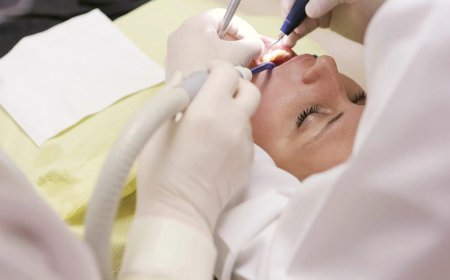How Orthodontists Help with Complex Braces Cases and Jaw Alignment?
When it comes to achieving a healthy, confident smile, many people turn to orthodontists for expert care. While general dentists handle routine oral health, orthodontists are specialists in correcting irregularities of the teeth and jaws.

When it comes to achieving a healthy, confident smile, many people turn to orthodontists for expert care. While general dentists handle routine oral health, orthodontists are specialists in correcting irregularities of the teeth and jaws. For individuals with complex braces cases or jaw misalignment, the expertise of an orthodontist is crucial. These specialists not only improve aesthetic appearance but also ensure proper oral function, which can positively affect overall health.
What Constitutes a Complex Braces Case?
Not all orthodontic treatments are straightforward. Some patients require more advanced interventions due to issues such as severe overcrowding, significant gaps between teeth, or complex bite problems like overbite, underbite, and crossbite. Additionally, cases involving impacted teeth, cleft palate, or congenital jaw abnormalities demand specialised knowledge and techniques.
A complex braces case usually involves a customised treatment plan that may include fixed braces, clear aligners, expanders, and in some instances, surgical procedures. Orthodontists have years of training beyond dental school, allowing them to diagnose and treat these intricate cases effectively.
The Role of Orthodontists in Jaw Alignment
Jaw misalignment, or malocclusion, occurs when the upper and lower jaws do not meet properly. This condition can cause functional issues such as difficulty chewing or speaking, facial pain, temporomandibular joint (TMJ) disorders, and even sleep apnoea in severe cases. Orthodontists play a pivotal role in identifying and treating these problems early.
Orthodontic treatment for jaw alignment often begins with diagnostic tools such as X-rays, 3D scans, and photographic analysis. Based on this data, orthodontists create a tailored treatment plan. Depending on the severity, they may use braces, headgear, or functional appliances to reposition the jaw gradually. In more complex situations, they work in conjunction with oral surgeons to perform corrective jaw surgery (orthognathic surgery).
Types of Braces for Complex Cases
Traditional Metal Braces
These are the most common and effective braces for complicated orthodontic issues. They use metal brackets and wires to slowly shift the teeth and jaws into alignment. While not the most discreet option, they are durable and highly effective.
Ceramic Braces
Similar in function to metal braces but made of clear or tooth-coloured materials, ceramic braces are a popular choice for adults and teens who want a less noticeable option without compromising effectiveness.
Invisible Braces (Clear Aligners)
Clear aligners, often referred to as invisible braces, are a more aesthetically pleasing option. Brands like Invisalign have made these a mainstream solution for mild to moderate alignment issues. However, some newer versions are designed to tackle more complex cases, sometimes in conjunction with attachments or elastics.
Its important to note that while clear aligners are increasingly sophisticated, not all complex cases are suitable for this treatment alone. An experienced orthodontist will determine whether they can be effectively used or if they need to be supplemented with other devices.
Orthodontist Cost for Braces
The cost of seeing an orthodontist varies depending on the complexity of the case, the type of treatment chosen, and the duration of the treatment. For standard metal braces, the orthodontist cost for braces in Australia typically ranges from $6,000 to $9,000 for a full treatment plan. More complex cases requiring additional procedures or surgical interventions may exceed this range.
Health insurance may cover a portion of the cost, especially for children and adolescents under private health extras cover. Payment plans are also commonly available at most orthodontic clinics to ease the financial burden.
Invisible Braces Cost in Australia
For those considering clear aligners, the invisible braces costin Australia generally ranges between $3,500 and $8,500, depending on the complexity and duration of the treatment. While they tend to be more expensive than traditional braces, many people find the discreet appearance and removability worth the investment.
Again, complex cases may require a hybrid approach where invisible braces are used in conjunction with other orthodontic appliances. The final cost will depend on the comprehensive treatment plan developed by the orthodontist.
The Importance of Choosing the Right Orthodontist
When dealing with complex orthodontic issues, selecting a qualified and experienced orthodontist is vital. Not only should they be registered with the Australian Health Practitioner Regulation Agency (AHPRA), but they should also have a proven track record in handling advanced cases.
A skilled orthodontist will conduct a thorough assessment, explain all available treatment options, and discuss expected outcomes and costs clearly. Regular follow-ups and adjustments will ensure the treatment progresses effectively and complications are promptly addressed.
In summary, orthodontists are indispensable when it comes to managing complex braces cases and correcting jaw alignment. Their specialised training and experience allow them to craft personalised treatment plans that not only enhance smiles but also improve oral function and overall well-being. Whether you're dealing with severe crowding, bite issues, or jaw misalignment, an orthodontist will guide you through the process with expertise and care. Understanding the orthodontist cost for bracesand invisible braces cost in Australia can help you make an informed decision about your treatment. While the financial commitment might be significant, the long-term benefitsboth aesthetic and functionalare well worth it. Investing in your smile is ultimately an investment in your health and confidence.



































![Play99 Login & Registration Guide for Indian Users [2025 Update]](https://www.atlantanewsplus.com/uploads/images/202507/image_140x98_6870c1df7bfcd.jpg)
